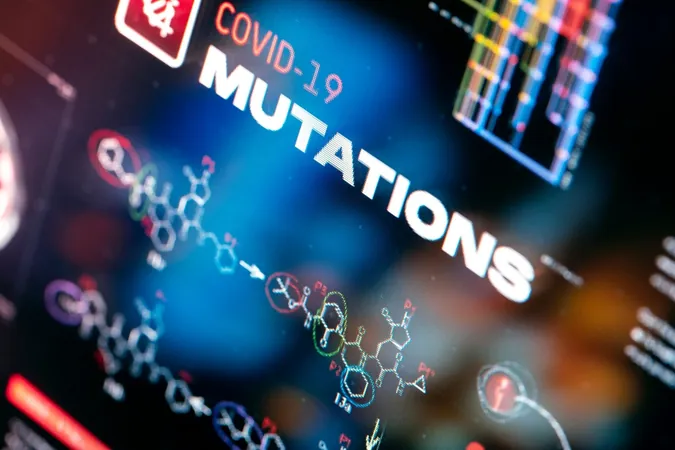
Breakthrough AI Method Decodes SARS-CoV-2 Genetic Changes, Predicting Future Variants!
2025-03-27
Author: Li
Breakthrough AI Method Decodes SARS-CoV-2 Genetic Changes, Predicting Future Variants!
It's been five long years since COVID-19 was declared a global pandemic, and as SARS-CoV-2 shifts toward an endemic status, the looming question of how the virus will evolve continues to haunt the scientific community. With vaccines and natural immunity in circulation, new variants could pose significant risks, potentially springing waves of renewed infections if the virus develops the ability to evade these defenses.
Understanding future mutations of viruses like SARS-CoV-2 is crucial for public health and safety. While traditional mutation research involves costly and slow wet-lab experiments, researchers at Florida Atlantic University (FAU) have unveiled an innovative approach that harnesses the power of artificial intelligence (AI) to streamline this predictive process.
The FAU team developed the Deep Novel Mutation Search (DNMS), an AI model that utilizes deep neural networks to anticipate mutations in protein sequences. Focusing specifically on the SARS-CoV-2 spike protein—vital for the virus to infiltrate human cells—they trained a specialized protein language model known as ProtBERT to identify and predict unprecedented mutations in this protein.
By mimicking the "dialect" of the SARS-CoV-2 spike proteins, the DNMS model analyzes mutations based on several criteria. This includes grammaticality—a measure of how linguistically correct a mutation is—along with semantic change and attention change, both crucial concepts in understanding protein structure and function.
The results of this research, which appeared in the journal Communications Biology, show that DNMS effectively categorizes viral sequences into groups based on similarities. The model excels in spotting mutations that cause minimal alterations to the protein's structural integrity, reflecting the evolutionary trend of viruses to make subtle changes without compromising their functionality.
Instead of merely comparing variations against a reference sequence, DNMS employs a parent-child mutation prediction framework. By using existing protein sequences to predict how mutations might evolve over time, the model can refine its predictions of potential future mutations.
“Our model ranks all possible mutations to identify those most likely to occur in the future,” said Dr. Xingquan “Hill” Zhu, a senior author and professor at FAU. “We found that mutations adhering to the protein's "grammars" and exhibiting minor changes are the most probable future mutations.”
The process begins with a designated SARS-CoV-2 spike protein sequence, and DNMS simulates various single-point mutations to evaluate each one’s likelihood of occurrence based on its alignment with grammatical rules. Furthermore, it assesses how much the mutations deviate semantically from the original protein.
The researchers also correlated predicted mutations with the virus's fitness—its ability to replicate and thrive—finding that mutations aligning closely with the biological rules of the spike protein were often advantageous for viral success. This insight emphasizes the model's potential to accurately forecast beneficial mutations that may arise.
“By leveraging sequence data, our predictions become more reliable, as proteins adhere to established biological rules,” added Zhu.
In evaluations, DNMS demonstrated superior performance compared to traditional methods, combining critical factors into a cohesive prediction framework. Dr. Stella Batalama, FAU's College of Engineering and Computer Science dean, noted that this AI-driven technique could enhance experimental research by allowing for foresight regarding mutations—giving public health officials a critical advantage in monitoring emerging threats before they proliferate.
The study, co-authored by doctoral student Magdalyn E. Elkin, signifies a vital step forward in virology, enabled by support from the United States National Science Foundation. With each novel approach, scientists can better navigate the turbulent waters of viral evolution, ensuring that humanity is prepared for whatever challenges lie ahead in the age of pandemics.
This research not only broadens our understanding of SARS-CoV-2 but also sets a powerful precedent for how technology can be utilized to combat future viral threats more effectively. Armed with these insights, we may just be one step closer to outsmarting the next wave of mutations!




 Brasil (PT)
Brasil (PT)
 Canada (EN)
Canada (EN)
 Chile (ES)
Chile (ES)
 Česko (CS)
Česko (CS)
 대한민국 (KO)
대한민국 (KO)
 España (ES)
España (ES)
 France (FR)
France (FR)
 Hong Kong (EN)
Hong Kong (EN)
 Italia (IT)
Italia (IT)
 日本 (JA)
日本 (JA)
 Magyarország (HU)
Magyarország (HU)
 Norge (NO)
Norge (NO)
 Polska (PL)
Polska (PL)
 Schweiz (DE)
Schweiz (DE)
 Singapore (EN)
Singapore (EN)
 Sverige (SV)
Sverige (SV)
 Suomi (FI)
Suomi (FI)
 Türkiye (TR)
Türkiye (TR)
 الإمارات العربية المتحدة (AR)
الإمارات العربية المتحدة (AR)